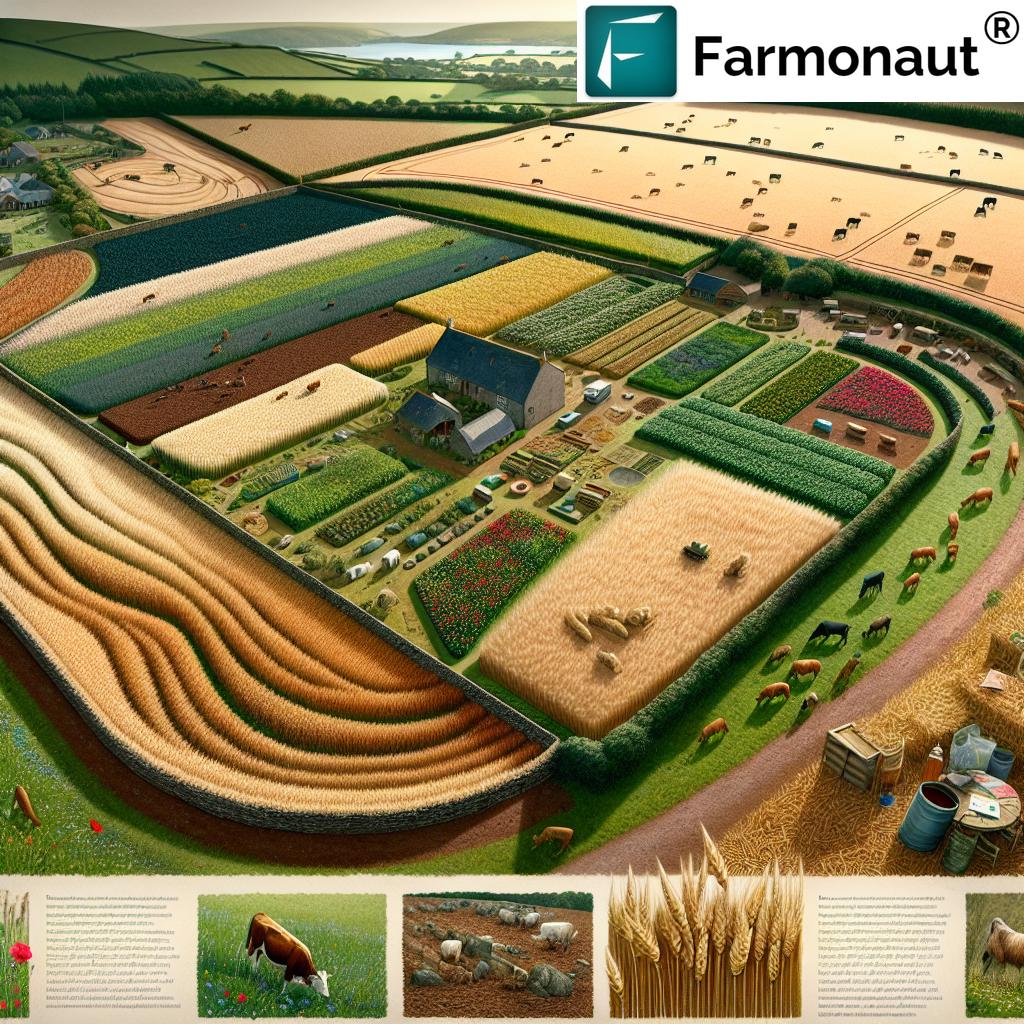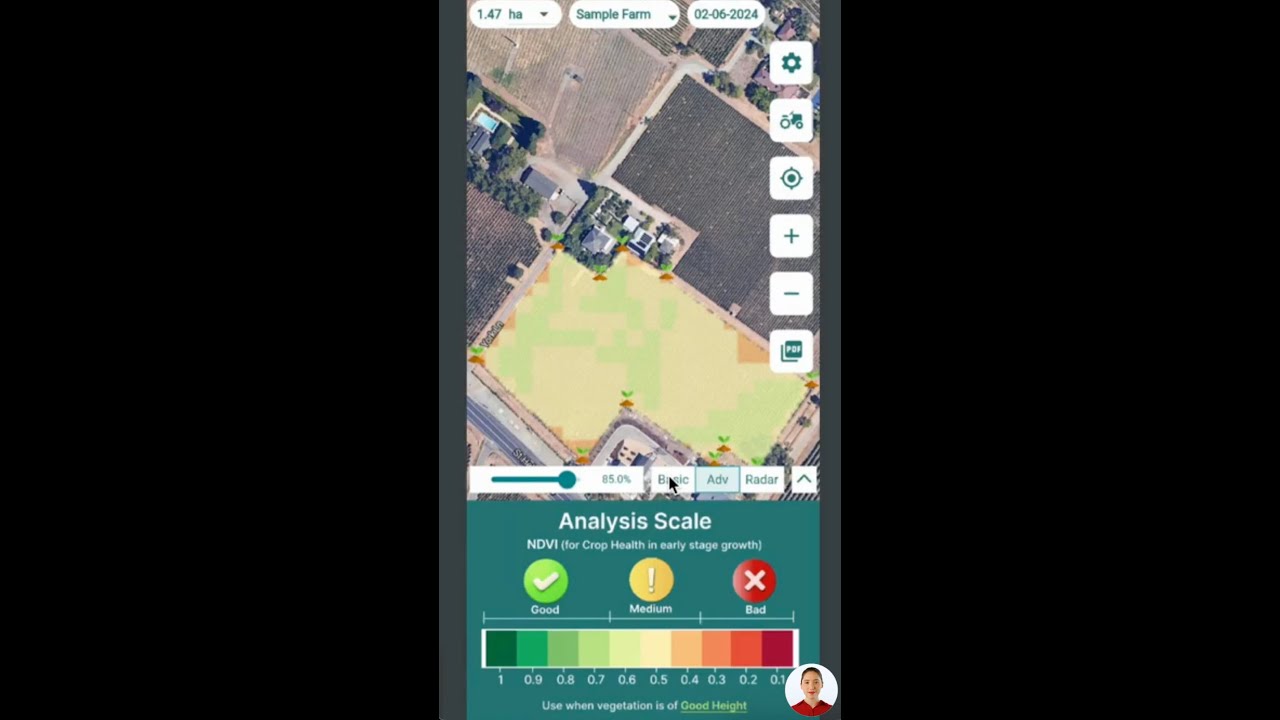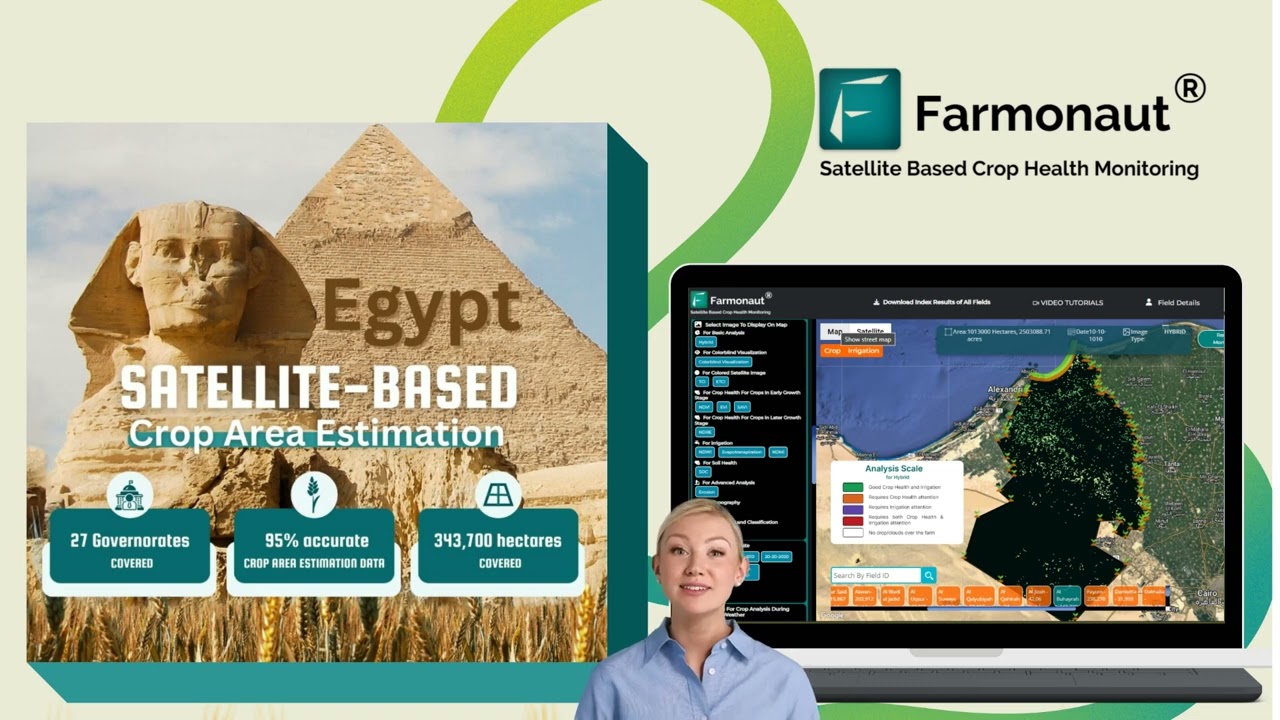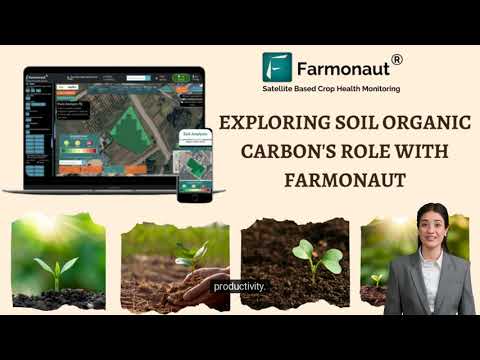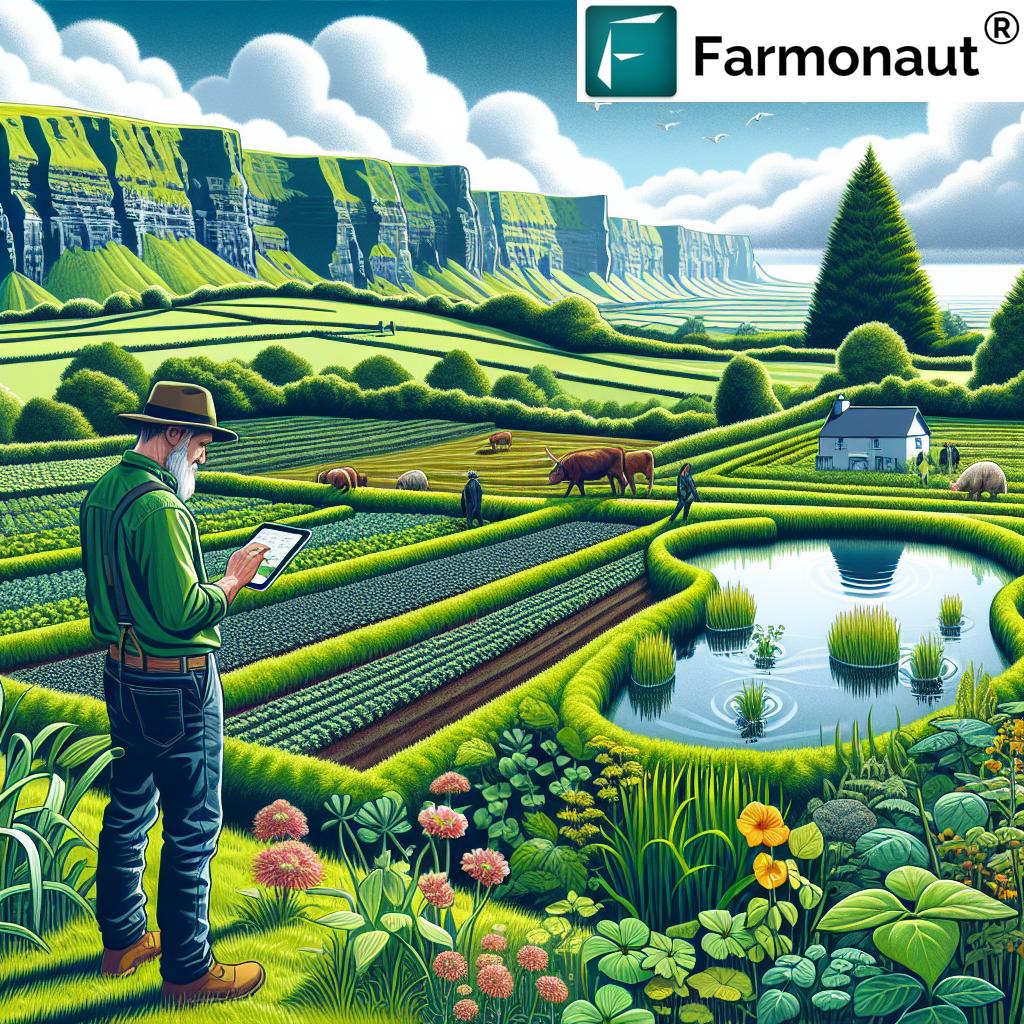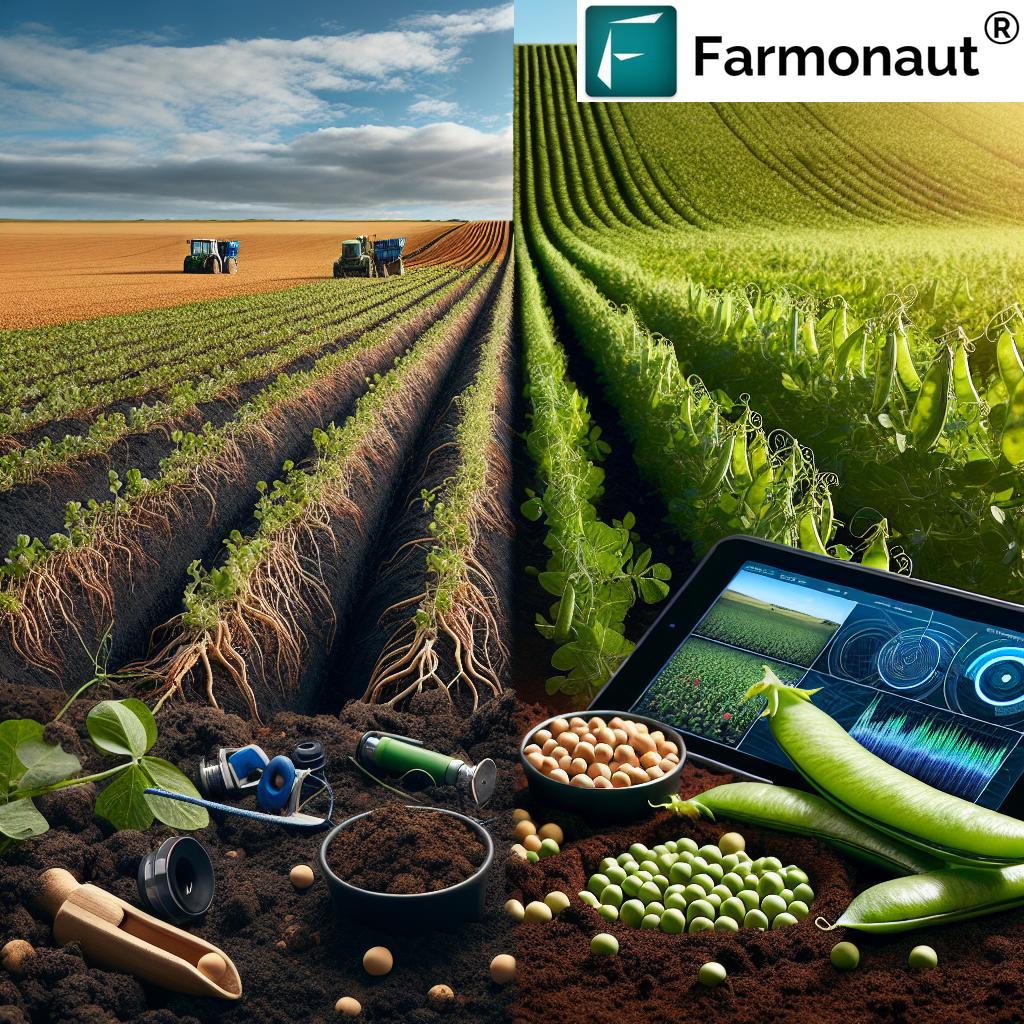Organic Farming Revolution: How Intercropping Cereals and Legumes Boosts Soil Health and Biodiversity in South Wales
“Intercropping cereals and legumes can reduce weed populations by up to 50% in organic farming systems.”

Welcome to our comprehensive guide on the organic farming revolution sweeping across South Wales! In this blog post, we’ll delve into the innovative world of intercropping cereals and legumes, exploring how this sustainable practice is transforming agriculture in the region. As we journey through the lush fields of Glamorgan and beyond, we’ll uncover the secrets behind soil health optimization, sustainable weed management, and the remarkable boost in biodiversity that these methods bring to our farms.
At Farmonaut, we’re committed to supporting farmers in their transition to more sustainable and profitable farming practices. Our cutting-edge satellite-based farm management solutions offer invaluable insights for those looking to optimize their organic farming techniques. Let’s dive into the world of cereal and legume intercropping and discover how it’s reshaping the agricultural landscape of South Wales.
The Rise of Organic Farming in South Wales
Organic farming has gained significant traction in South Wales over the past decade. Farmers across the region are increasingly recognizing the long-term benefits of eschewing chemical inputs in favor of natural, sustainable methods. This shift is not just a trend; it’s a response to growing consumer demand for healthier, environmentally friendly produce and a recognition of the need to protect our precious ecosystems.
- Increased consumer awareness of food origins
- Growing concern for environmental sustainability
- Government incentives for organic transition
- Desire to improve soil health and biodiversity
As organic farming takes root in South Wales, innovative techniques like intercropping are emerging as game-changers in sustainable agriculture. Let’s explore how this practice is revolutionizing organic crop management.
Understanding Cereal and Legume Intercropping
Intercropping is the practice of growing two or more crops in the same field simultaneously. When it comes to cereals and legumes, this combination is particularly powerful. Cereals like wheat, oats, and barley are paired with legumes such as beans, peas, or clover to create a symbiotic relationship that benefits both crops and the environment.
Benefits of Cereal-Legume Intercropping:
- Enhanced nitrogen fixation in the soil
- Improved soil structure and fertility
- Natural weed suppression
- Increased biodiversity
- Better resource utilization
- Higher overall yields
By implementing these intercropping systems, organic farmers in South Wales are seeing remarkable improvements in their arable crop management and overall farm health.
Soil Health Optimization through Intercropping
One of the most significant benefits of cereal-legume intercropping is its impact on soil health. This practice is a cornerstone of organic farming techniques, particularly in the rich agricultural lands of South Wales.
How Intercropping Improves Soil Health:
- Nitrogen Fixation: Legumes have a unique ability to fix atmospheric nitrogen into the soil, making it available for the companion cereal crop and future plantings.
- Organic Matter Increase: The diverse root systems and plant residues contribute to higher levels of organic matter in the soil.
- Soil Structure: Different root types improve soil structure, enhancing water retention and reducing erosion.
- Microbial Activity: The variety of plants supports a more diverse and active soil microbiome.
At Farmonaut, we provide farmers with advanced satellite imagery and AI-driven insights to monitor soil health and crop performance. Our web app allows farmers to track these improvements over time, ensuring they’re maximizing the benefits of their intercropping systems.

Sustainable Weed Management in Organic Systems
Weed control is often cited as one of the biggest challenges in organic farming. However, cereal-legume intercropping offers a natural and effective solution to this problem.
Weed Suppression Mechanisms in Intercropping:
- Increased ground cover reduces light availability for weeds
- Complementary crop growth patterns outcompete weeds for resources
- Allelopathic effects from certain crops naturally inhibit weed growth
- Diverse crop rotations disrupt weed life cycles
By adopting these organic farming techniques, farmers in South Wales are significantly reducing their reliance on chemical herbicides while maintaining productive and weed-free fields.
“Organic crop rotation with ryegrass and clover leys can increase soil organic matter by 20-30% over 3-5 years.”
Biodiversity Boost: The Ecological Impact of Intercropping
Intercropping cereals and legumes doesn’t just benefit the crops and soil; it creates a thriving ecosystem that supports a wide range of flora and fauna. This increase in biodiversity is crucial for maintaining ecological balance and promoting natural pest control.
Biodiversity Benefits of Intercropping:
- Increased habitat diversity for beneficial insects
- Support for pollinators throughout the growing season
- Enhanced soil biodiversity, including microorganisms and earthworms
- Improved resilience against pests and diseases
- Creation of wildlife corridors in agricultural landscapes
Farmonaut’s satellite monitoring technology helps farmers track these ecological changes, providing valuable data on vegetation health and land use patterns. Our Android app makes this information easily accessible, allowing farmers to make informed decisions that support biodiversity on their farms.

Organic Crop Rotation: Maximizing the Benefits of Intercropping
While intercropping provides numerous benefits, its effectiveness is maximized when incorporated into a well-planned organic crop rotation system. In South Wales, farmers are seeing remarkable results by integrating cereal-legume intercrops with fertility-building leys of ryegrass and clover.
Key Elements of Effective Organic Crop Rotation:
- Alternating nitrogen-fixing crops with heavy feeders
- Including deep-rooted crops to improve soil structure
- Incorporating green manures and cover crops
- Balancing cash crops with soil-building phases
- Adapting rotations to local climate and soil conditions
By implementing these rotations, organic farmers in South Wales are not only improving their soil health but also managing pests and diseases more effectively, reducing the need for external inputs.
Organic Oat Cultivation: A South Wales Success Story
Oats have emerged as a star player in South Wales’ organic farming revolution. Their hardiness and adaptability make them an excellent choice for intercropping systems and organic rotations.
Why Organic Oats Thrive in South Wales:
- Well-suited to the region’s climate
- Excellent weed-suppressing abilities
- High nutrient efficiency
- Strong market demand for organic oats
- Versatility in crop rotations
Farmers using Farmonaut’s technology can monitor their oat crops’ health and growth patterns, ensuring optimal management throughout the growing season. Our iOS app provides real-time alerts and insights, helping farmers make data-driven decisions for their organic oat production.

Integrating Livestock in Mixed Farming Systems
Many organic farms in South Wales are taking their sustainability efforts a step further by integrating livestock into their arable systems. This approach, known as mixed farming, offers numerous benefits for soil health, biodiversity, and overall farm productivity.
Advantages of Integrating Livestock:
- Natural fertilization through manure
- Improved nutrient cycling
- Diversified income streams
- Enhanced pest and weed control
- Utilization of crop residues as feed
Sheep and cattle are particularly well-suited to grazing on fertility-building leys, while pigs can be used for stubble management in cereal fields. This integration creates a more closed-loop system, reducing the need for external inputs and improving overall farm sustainability.
Nitrogen Fixation Strategies in Organic Farming
Nitrogen management is crucial in organic farming systems, and legumes play a vital role in this process. Understanding and optimizing nitrogen fixation can significantly reduce the need for external fertilizers while improving soil fertility.
Key Nitrogen Fixation Strategies:
- Selection of appropriate legume varieties
- Inoculation with rhizobia bacteria
- Optimal planting times and conditions
- Management of soil pH and nutrient levels
- Incorporation of legume residues into the soil
By implementing these strategies, organic farmers in South Wales are creating more self-sufficient and sustainable farming systems. Farmonaut’s API allows farmers to integrate nitrogen fixation data with other farm management tools, providing a comprehensive view of their farm’s nutrient dynamics.
Heritage Wheat Varieties: Rediscovering Ancient Grains
In recent years, there has been a resurgence of interest in heritage wheat varieties among organic farmers in South Wales. These ancient grains offer unique flavors, nutritional profiles, and adaptability to local growing conditions.
Benefits of Growing Heritage Wheat:
- Enhanced disease resistance
- Better adaptability to organic systems
- Unique market appeal
- Contribution to genetic diversity
- Potential for higher nutritional value
Varieties like Emmer, Einkorn, and Spelt are finding their way into organic rotations, often intercropped with legumes for optimal soil health and productivity. Farmonaut’s satellite monitoring can help farmers track the performance of these heritage varieties, ensuring successful integration into their farming systems.
Local Food Systems and Farm Shops
The organic farming revolution in South Wales is closely tied to the development of robust local food systems. Farm shops and farmers’ markets have become essential outlets for organic produce, creating direct connections between farmers and consumers.
Advantages of Local Food Systems:
- Reduced food miles and carbon footprint
- Fresher, more nutritious produce
- Support for local economies
- Increased food security
- Enhanced community connections
Many organic farmers in the region are diversifying their operations to include on-farm processing and direct sales, adding value to their products and creating additional income streams.
Circular Economy: Nutrient Use and Composting
Organic farming in South Wales is embracing the principles of the circular economy, with a strong focus on efficient nutrient use and composting. This approach minimizes waste and maximizes the use of on-farm resources.
Key Aspects of Circular Nutrient Management:
- On-farm composting of crop residues and animal manures
- Use of green manures and cover crops
- Integration of agroforestry systems
- Recycling of organic waste from local communities
- Biochar production and application
These practices not only improve soil health but also reduce the farm’s reliance on external inputs, creating a more sustainable and resilient agricultural system.
The Role of Technology in Organic Farming
While organic farming focuses on natural processes, technology plays a crucial role in optimizing these systems. Farmonaut’s satellite-based farm management solutions are at the forefront of this technological integration, providing organic farmers with valuable insights and tools.
How Farmonaut Supports Organic Farmers:
- Real-time crop health monitoring
- AI-driven advisory systems for organic management
- Precision agriculture tools for resource optimization
- Weather forecasting and risk assessment
- Data-driven decision support for crop rotations and intercropping
By leveraging these technologies, organic farmers in South Wales can make more informed decisions, improve their productivity, and enhance the sustainability of their operations. For more information on how to integrate Farmonaut’s solutions into your organic farming practices, check out our API Developer Docs.
Comparative Benefits of Intercropping
| Aspect | Cereal-Legume Intercropping | Traditional Monoculture | Percentage Improvement |
|---|---|---|---|
| Soil Health (Organic Matter %) | 4.5% | 3.0% | 50% |
| Biodiversity (Species Count) | 75 | 30 | 150% |
| Weed Suppression (% Reduction) | 70% | 40% | 75% |
| Nitrogen Fixation (kg/ha/year) | 150 | 0 | N/A |
| Crop Yield (tonnes/ha) | 6.5 | 5.5 | 18% |
Challenges and Future Directions
While the organic farming revolution in South Wales has made significant strides, challenges remain. These include:
- Managing the transition period for conventional farmers
- Addressing labor intensiveness of some organic practices
- Developing markets for diverse organic products
- Adapting to climate change impacts
- Ensuring economic viability in competitive markets
However, with continued innovation, support from technology providers like Farmonaut, and growing consumer demand for organic products, the future of organic farming in South Wales looks bright.
Conclusion
The organic farming revolution in South Wales, centered around intercropping cereals and legumes, is transforming the agricultural landscape. By embracing these sustainable practices, farmers are not only improving soil health and biodiversity but also creating more resilient and profitable farming systems.
At Farmonaut, we’re committed to supporting this revolution with our cutting-edge satellite-based farm management solutions. Whether you’re an established organic farmer or considering the transition, our technology can help you optimize your operations and achieve your sustainability goals.
Join us in cultivating a healthier, more sustainable future for agriculture in South Wales and beyond!
FAQ Section
Q: What are the main benefits of intercropping cereals and legumes?
A: The main benefits include improved soil health, increased biodiversity, natural weed suppression, enhanced nitrogen fixation, and potentially higher overall yields.
Q: How does organic farming contribute to biodiversity?
A: Organic farming practices, especially intercropping, create diverse habitats that support a wide range of insects, birds, and other wildlife. They also promote soil biodiversity through reduced chemical inputs and increased organic matter.
Q: Can organic farming be as productive as conventional farming?
A: While yields can be lower during the transition period, well-managed organic systems can achieve comparable productivity to conventional systems over time, especially when considering total farm output rather than single crop yields.
Q: How does Farmonaut’s technology support organic farmers?
A: Farmonaut provides satellite-based crop monitoring, AI-driven advisory systems, and precision agriculture tools that help organic farmers make informed decisions, optimize resource use, and improve overall farm management.
Q: What are some challenges in transitioning to organic farming?
A: Challenges include managing soil fertility without synthetic inputs, controlling pests and diseases naturally, potential yield reductions during the transition period, and developing markets for organic products.
